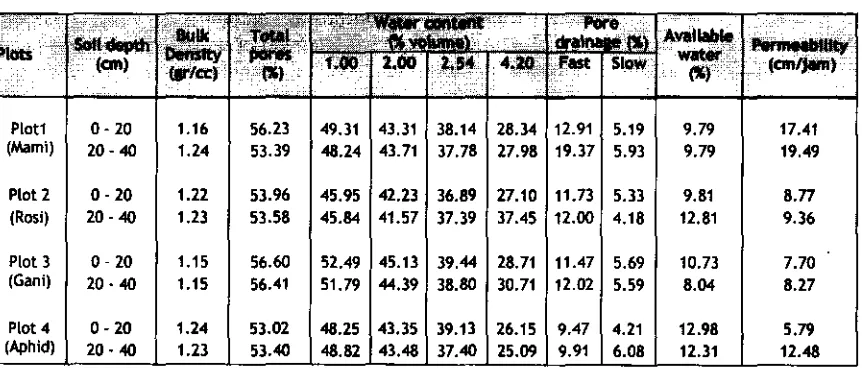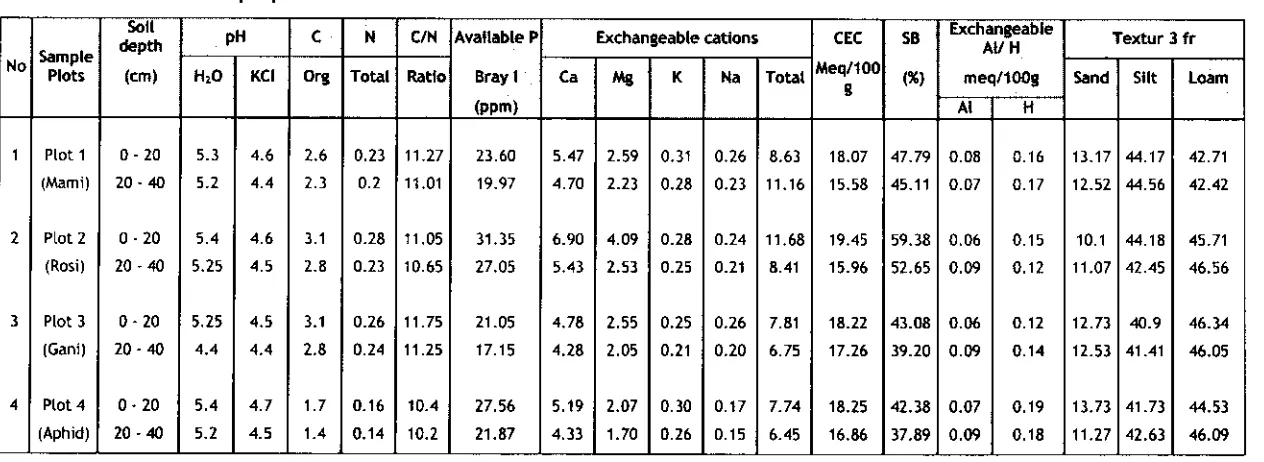DIVERSITY OF ARBUSCULAR
MYCORRHIZAL FUNGI
AND MYCORRHIZAL PLANT
STATUS
AT AGROFORESTRY SITES
OF
GUNUNG
WALAT
EDUCAIONAL FOREST
5.
~ilarsol,
I.
Mansur', A. ~ukendro', I.Z. siregar',E.A.
Husaenfl
& ~upriyanto''~aboratory
of
Silviculture; Labom tory of ForestEntomoIogy
The Department
of
Forest
Management Faculty of Forestry, m o r Agrfcuiturul UniversityPO Box 168, Bqor IM101, Indonesia Email: swiIorso@hotmaf t
.
cornIntroduction
Gunung Walat
i s
aneducational forest managed by Faculty of Forestry Bogor
Agricultural University. The forest
wasbothered by farmers who live around the
forest since 1997 due to Indonesian economic
crises.Consequently, the forest
becamedegraded.
It i snot
easy torehabilitate the degraded
sttes
for several
majorconstrains
related
toexisting unfavorable
environmental
conditions
a t the degraded sites. Edaphic
factors ([ow nutrients, acidic soits), climatic
factors(high
lwelof solar radiation and high
temperatures) and biological
factm
and low
soilmicrobial activiti-) are
some
of these
ledto reduced
performanceof planted tree.
The
application
of beneficialmicrobial technology
suchas
mycorrhizalfungi
asalternative strategy should be attempted and
developed i n order
toincrease
thesurvival, quality and
growthrate
ofM l i n g
and
plantp r d d v i t y in
thefield.
Arbuscular mycorrhizal fungi
(AMF)
belong to the Glomales (Zygomycetes), and
about 130 m e s in thegenera
Glomus,
Scterocystis, Gigaspora, Enthtropospora, Scutellosporaand Acaulospora have
upto now
beenrecognized as forming symbiotic associations with
plants
(Schenk and Perez,1990).
These
fungi areextremely
widerpread; theynot
limited to any one plant family and
have
an exceptionally wide range
of host and habitat
(Smith and
Read,1997),
Thenovel function of this
fungi asbiological agent
for plantprductivity
aswell as for bioremediation of
heavymetal contaminated soil (Setiadi,
1998, Hashem,
1995) helping agent In early seedling establishment on degraded sitesare recognized.
arburcular
mycorrhizal fungi
(AMF)have also
beenemployed to
increase resistance
toplant pathogens (Liu,
1995)and Salinity (Azcon and ~l-Atrash,
r
997).To assess
whether introduction
ofarbuscular mycorrhizal fungi
(AMF)into
agiven
ecosystem beneficial,
iti s
necessaryto evaluate
theimportance
of the indigenous
mycorrhizal population.
The
recent
workaimed to
knowthe
diversity of
AMFand plant mycorrhizal status i n
Gunung Walat Educationai Forest that further useful for supporting site rehabilitation
through agroforestry system.
Methodology
plants grown
atdifferent soil depth (0-20 cm) and
20-40cm).
A 50 g sub-sampIe from
soil sample was weighed and
sieved toIsolate
the
AMF
spore
according the method of
Nicholson and Gaderman (1963), and the
rest
of thesamples were
fortrapping
to
induce the praduction of mores spores for further study. The soil was also analyzed
for their
physicaland chemical properties.
Theisolated spores were identified under
microscope to genus level.
The root samples collected were stained
byPhilip
and Hayman (1970)method and the
rootcolonization were observed under the
microscope.
Results and Discussion
Physical
propertiesof
soil
Results
of theanalyses
ofthe physicat properties of soil
samples collected from each
site are presented i n Table 1.
Table
1.
Thephysical
propertiesof soil samples.
Physical
propertiesamong
the four
plotswere generally similar, except for
their
permeability. Plot 1
hasthe highest permeability, while the upper tayer
(0-20cm) of
Plot
4 has thelowest.
Plot 3
(Gmi)
Plot 4 (Aphid)
Chemical properties
of
soil
Generally,
upper layer ofthe
soil
(0-20cm) has
better chemical property compared
with the lower layer (Table 2). SoiI pH
of thesoil
wasgenerally acidic
(4.4-5.4),and
Naand K content were low,
but Mg and
Cawere high, and
P
was medium
tohigh. The
C-organiccontent
inPlot
4 waslow,
whilein
the
three other plots was medium,
Thekation
exchangecapacity i n all plots
wascommonly medium (Table
2).0 - 20 20
-
400 - 20 20
-
40Diversity of AMF
Analyses of biological properties of soil were
focusedon
thebeneficial microorganism
forpromoting plant
growth,especially arbuscular mycorrhizal fungi
AMF).
Results
of theA M F
analyses are presentedi n Table
3.1.15 1.15
1.24 1.23
56.60 56.41
53.02 53.40
52.49 51.79
48.25 48.82
45.13 44.39
43.35 43.48
39.44
38.80
39.13 37.40
28.71 30.71
26-15 25.09
11.47 12.02
9.47 9.91
5.69 5.59
4.21 6.08
10.73 8.04
12.98 12.31
7.70 8.27
[image:2.557.78.509.244.430.2]Table 2. The chernicai properties of soiI. No 1 2 3 4 Sample Plots
P l o t 1
(Mami)
P l o t 2 (Rosi)
P l o t 3 (Gani)
Plot4
(Aphid) Soil h P m
(cm)
0 - 2 0
20-40
0 - 2 0
20-40
0 - 2 0
2 0 - 4 0
0 . 2 0 2 0 - 4 0
PH C
Orq 2.6 2.3 3.1 2.8 3.1 2.8 1.7 1.4 A Hz0 5.3 5.2 5.4 5.25 5.25 4.4 5.4 5.2 KC1 4.6 4.4 4.6 4.5 4.5 4.4 4.7 4.5 N Total 0.23 0.2 0.28 0.23 0.26 0.24 0.16 0.14 CIN
R a t b
11.27 11.01 11.05 10.65 11.75 11.25 10.4 10.2
Available P
Bray 1
( P P ~ )
23.60 19.97 31.35 27.05 21.05 17.15 27.56 21.87
Exchangeable cations CEC
MeqIlOO B 18.07 15.58 19.45 15.96 18.22 17.26 18.25 16.86 Ca 5.47 4.70 6.90 5.43 4.78 4.28 5.29 4.33 SB (96) Mg 2.59 2.23 4.09 2.53 2.55 2.05 2.07 1.70 K 0.31 0.28 0.28 0.25 0.25 0.21 0.30 0.26 ExchangeabLe
AUH Textur 3 fr
meqlt00g Sand Silt Loam
[image:3.691.31.663.122.353.2]Tabte 3. Spore numbers and AMF diversity in study site.
Table 3 shows that there were differences in spore numbers and diversity. Plots 1 and
2 have the highest number of AMF spores, respectively. Spore numbers and were highest in the upper part of soil Layer, and getting iower with depth.
Plant Diversity and Mycorrhizal Status
No
1
2
3
4
The plants diversity and mycorrhizal status collected from four different Locations in Gunung Walat educational Forest varied (Table 4). Among 2 tree species assessed, ail had mycorrhizae and 12 crops species assessed, 10 of them had rnycorrhizae.
[image:4.530.61.491.41.181.2]Spora Number/
50g
soil
Table 4. The plant species found in plots of study. Location
Plot 1 (Mami)
Plot 2 (Rosi) 1
Plot 3 (Gani)
Plot 4
Glomus
133
34' 12
10
55 15
1
08
87 Depth(cm)
.0
- 2020 - 40
0 - 2 0
20 - 40
0
-20
20
- 400
-20
(Aphid)1
20 - 40Gigaspora
2 1 210
2 1 1
No
PlotPLot 1
(Mami)
Plot 2 (Rosi )
Plot 3
(Gani)
Plot 4 (Aphid)
Acaslaspora
1
3
1
3
1 73
1
Name
of
plant
species
Agathis lorantifolia
Coffe robus
Salacca edul is Monihot esculata
Cardamom sp
M usa paradisiaca
Copsicurn sp,
Lenca
Taro
Anonas cornusus
Sereh
Accacia mongium A ~ h a t i s lorantifolio Coffe robusto
Salacca edulis
Manihot esculenta
Cadamon s p
M usu paradisiaca
Taro
Gude
Musa paradisiaca
Gude
Leunca
Musa paradisiacal
O ~ y r a sativa
Manihot esculanto
Gude
Mycorrhira
l
status
+ + +
+
+
+
+
+
+
+
+
+
+
+
+
+
+
+
+
[image:4.530.60.490.352.699.2]Based on the physical, chemical and biologicat properties analyses, the soil in Gunung Walat Educational forest has generally low to medium fertility. Plot 4 has the lowest fertility, this might be caused by the removal of trees (trees have been previously clear cut), which reduced the production of organic matter and increased soii erosion. In this type of site, input, such as inorganic, organic fertilizer, and bio-fertilizer need to be applied to improve trees and crops productivities.
The analysis of bioiogicai properties of the soil found diverse morpho-types of mycorrhizal spores, which could be grouped into three genera, i.e.
Gigospora,
Glomwand Acaulospora. The potential and application of mycorrhiza to enhance plant growth and productivity has been widely known (Budi e t a/., 1998; Smith and Read, 1997; Lemoine e t
al.,
7992).The richness of arbuscular mycorrhizal fungi (AMF) spore found in Plot 1 might be due to the favorable sites for sporulation, and abo the plant species found i n that plot were more divers than the other plot (Table 4). According to Abbott and Gazey
(1994), there are many factors that affect the sporulation of arbuscular mycorrhizal fungi (AMF) i.e.: the host, edaphic, climate and biological factor.
The diversity of arbuscular mycorrhizal fungi (AMF) studied at the site show that the
upper layer of the soii were more divers than the lower layer, this might be
correspond with the physical and chemical properties of the soil (see Table 2 and 3).
The arbuscular rnycorrhizat fungi (AMF) species and spore number i s dominated by
Glornus sp followed by Gigaspora sp.
The data presented in Table 3 indicate that there are particular patterns in the
formation and sporulation of arbuscular mycorrhizal fungi (AMF) which depend largely on the characteristics of the site. According to the hypothesis of Cornnell (19781, the diversity of species should be lower for minimal and maximal disturbance, for recent
and distant disturbance and for minor and major levels of disturbance than that of
intermediate levels of disturbance. Due to i t s obligate symbiotic, the abundance of arbuscular mycorrhizal fungi (AMF) i n the ecosystem certainly depend on the host i n
the site.
Those data also indicate that the abundance of AMF found i n Agroforestry site that
can be subsequently used as a bank of glornaiean fungi. A large diversity of arbuscular mycorrhizal fungi (AMF) found on those site, could be used as a base for selecting effective arbuscular mycorrhizat fungi (AMF) to be used for increasing the crop productivity in A~roforestry system.
Conct usions
1. Thesoilfertilityof A~roforestrysiteinGunung Walatwas low tomedium.
2. Beneficial microbes, especially mycorrhiza (AMF) were found i n the site and could be used to devetop bio-fertilizer i n the near future.
3. The diversity of AMF varied depend on the site condition and the soil depth
4. Almost the plant species found in the site had mycorrhizae.
References
Azcon, R., E.L. Atrash, F. 1997. Influence of arbuscular mycorrhizae and phosphorous fertilization on growth, nodulation and Nz fixation ( N ' ~ ) in Medicogo sativa at four salinity levels. Biology and Fertility of Soils 24: 8 1 -86
Budi S.W., S. Gianinazzii and J.P. Caussanel. 1998. The Biotechnotogy of
mycorrhizae. In Microbial Interactions in Agriculture and Forestry (Vol. I).
Subba Rao, N.S. and Y.R. Dommergues (Eds.). Oxford and IBH Publishing Co.
PVT,
Ltd, New Delhi. P 149-1 62.Cornel(, J. H. 1978. Diversity in tropical rainforest and coral reefs. Science 199,1302-
1310.
Hashem, A.R. 1995. The role of mycorrhizal infection in the resistance of Voccinium macrocarpurn to manganese. Mycorrhiza 5: 289-292.
Lemoine M.C., 5 . Gianinazzi and P. Gianinazzi-Vivienne, 1992. Application of
endomycorrhizae to commercial production of Rhododendron micro plants. Agronomie, 12, 881 -885.
Liu, R-J.
1995.
Effect of vesicular-arbuscular mycorrhizal fungi onVerticillium
wilt of cotton. Mycorrhiza 5: 293-297.Setiadi, Y. 1998. Biodiversity of arbuscular mycorrhizal fungi a t PT. Freeport Indonesia. Ecology Laboratory Report. (unpublished).
Schenk, N.C., Y. Perez., 1990. Manual for the identification of VA mycorrhizal fungi. Gainesvi I le, Florida.


